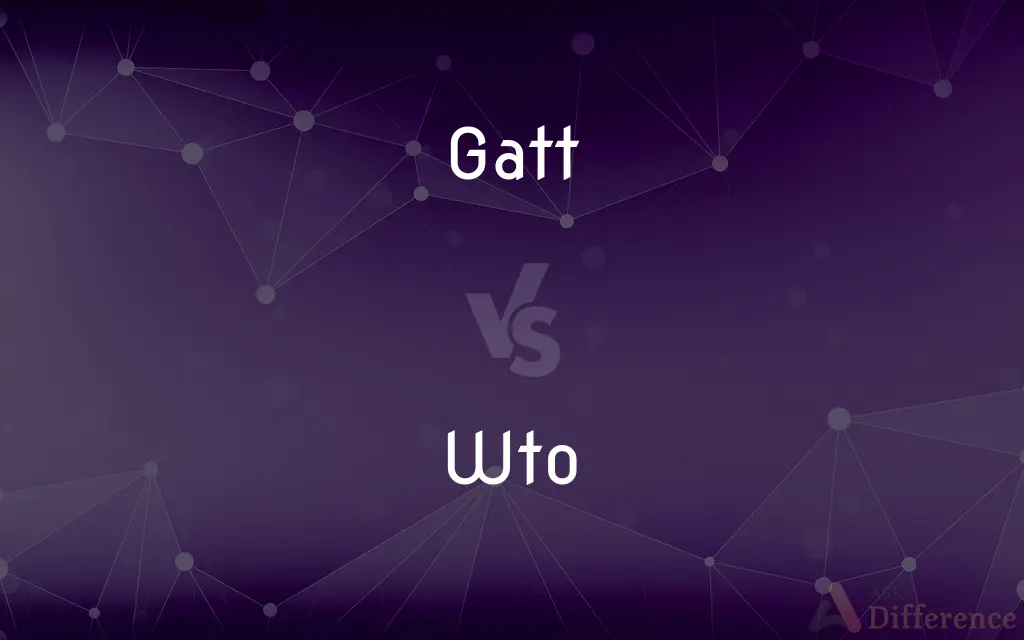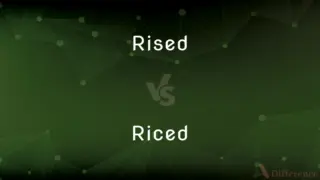GATT vs. WTO — What's the Difference?
Edited by Tayyaba Rehman — By Urooj Arif — Updated on April 18, 2024
GATT, established in 1948, primarily focused on regulating international trade through tariff negotiations, whereas the WTO, founded in 1997, offers a broader framework including trade services, intellectual property, and dispute resolution.

Difference Between GATT and WTO
Table of Contents
ADVERTISEMENT
Key Differences
GATT, or the General Agreement on Tariffs and Trade, was created to reduce tariffs and other trade barriers internationally, emphasizing the liberalization of trade in goods. Whereas the World Trade Organization (WTO) not only continues these efforts but also addresses trade in services, intellectual property rights, and provides a mechanism for dispute settlement.
GATT functioned as a provisional agreement and a multilateral treaty regime that operated through rounds of negotiations aimed at reducing trade barriers. On the other hand, the WTO is a permanent institution with a more structured framework for trade negotiations and enforcement of trade agreements.
Under GATT, the focus was largely on tariff reductions. Whereas, the WTO’s agreements cover a wider array of trade issues including non-tariff barriers and agricultural subsidies, which have broader implications for global trade policies.
The dispute resolution system under GATT was less formal and less binding, mainly relying on diplomatic negotiations to settle disputes. On the other hand, the WTO established a formal dispute resolution mechanism that is considered more effective and binding, which enhances its ability to enforce trade rules.
GATT was a smaller group of countries initially focused primarily on developed nations. Whereas the WTO expanded to include a larger number of countries, including developing and least developed countries, reflecting a more global representation.
ADVERTISEMENT
Comparison Chart
Establishment
1948
1995
Scope
Tariff reductions on goods
Comprehensive trade rules including goods, services, and intellectual property
Membership
Originally 23 countries
164 member countries as of 2021
Dispute Resolution
Informal and less binding
Formal and legally binding
Focus Areas
Mainly goods
Goods, services, agriculture, intellectual property, etc.
Compare with Definitions
Gatt
An international trade treaty designed to boost economic recovery after WWII.
GATT was pivotal in reducing global tariffs and fostering trade.
Wto
Covers a wide range of trade issues including intellectual property and services.
The WTO agreements are comprehensive, covering more than just trade in goods.
Gatt
Concentrated on the regulation and reduction of customs tariffs.
GATT successfully lowered tariffs worldwide over several negotiation rounds.
Wto
Established to provide a stable and permanent environment for trade negotiations.
Unlike GATT, the WTO has a fixed structure and headquarters in Geneva.
Gatt
GATT facilitated multilateral negotiations aimed at tariff reductions.
The GATT rounds were crucial in establishing common ground among trading nations.
Wto
Features a structured and binding dispute resolution system.
WTO’s dispute settlement body has the authority to enforce trade rules.
Gatt
Initially intended as a temporary setup.
GATT operated under a provisional protocol until the establishment of the WTO.
Wto
A global international organization dealing with the rules of trade between nations.
The WTO helps facilitate and regulate international trade and resolve disputes.
Gatt
Aimed at reducing trade barriers among member countries.
GATT’s efforts significantly liberalized global trade in the mid-20th century.
Wto
Includes a diverse membership encompassing over 160 economies from around the world.
WTO membership includes both developed and developing nations, promoting global trade inclusivity.
Gatt
A United Nations agency created by a multinational treaty to promote trade by the reduction of tariffs and import quotas.
Wto
An international organization based in Geneva that monitors and enforces rules governing global trade
Gatt
A United Nations agency created by a multinational treaty to promote trade by the reduction of tariffs and import quotas
Common Curiosities
Can WTO member countries still follow GATT principles?
Yes, WTO agreements incorporate GATT principles and expand on them to include additional areas of trade.
How did the dispute resolution mechanisms of GATT and WTO differ?
GATT had an informal dispute resolution process, while the WTO’s is formal and legally binding.
What types of trade does the WTO cover that GATT did not?
WTO covers trade in services, intellectual property, and more, whereas GATT was focused primarily on goods.
What is the main focus of GATT?
GATT primarily focused on tariff reductions on goods.
How does WTO differ from GATT in terms of structure?
WTO is a permanent institution with a comprehensive legal and institutional framework, unlike the provisional nature of GATT.
What challenges did GATT face that led to the creation of the WTO?
Challenges included limited scope, lack of institutional framework, and the need for more comprehensive trade rules.
What is the impact of WTO’s broader mandate on global trade?
It has led to more comprehensive trade agreements that address a wider range of issues affecting global trade.
Why was the WTO formed if GATT already existed?
The WTO was formed to provide a more structured and comprehensive framework for international trade beyond the scope of GATT.
What is the significance of the multiple rounds of negotiations under GATT?
These rounds were aimed at reducing tariffs and were crucial in shaping international trade policies.
How does the inclusion of intellectual property in WTO agreements affect member countries?
It ensures that intellectual property rights are respected and enforced internationally, benefiting creators and innovators.
What role did developing countries play in GATT and WTO?
Developing countries have a more significant and active role in the WTO compared to their limited influence in the early years of GATT.
How many countries were initially part of GATT and how does it compare to the WTO?
Initially, 23 countries were part of GATT; the WTO has expanded to include 164 member countries.
What is the future role of the WTO in global trade?
The WTO aims to continue facilitating trade negotiations, resolving disputes, and addressing emerging global trade challenges.
How are trade disputes resolved under the WTO?
Trade disputes are resolved through a structured process that includes panels and, if necessary, an appellate body.
How have GATT and WTO contributed to global economic growth?
Both have contributed by reducing trade barriers and standardizing international trade rules, enhancing global economic integration.
Share Your Discovery

Previous Comparison
Rised vs. Riced
Next Comparison
Galleria vs. GalleryAuthor Spotlight
Written by
Urooj ArifUrooj is a skilled content writer at Ask Difference, known for her exceptional ability to simplify complex topics into engaging and informative content. With a passion for research and a flair for clear, concise writing, she consistently delivers articles that resonate with our diverse audience.
Edited by
Tayyaba RehmanTayyaba Rehman is a distinguished writer, currently serving as a primary contributor to askdifference.com. As a researcher in semantics and etymology, Tayyaba's passion for the complexity of languages and their distinctions has found a perfect home on the platform. Tayyaba delves into the intricacies of language, distinguishing between commonly confused words and phrases, thereby providing clarity for readers worldwide.















































